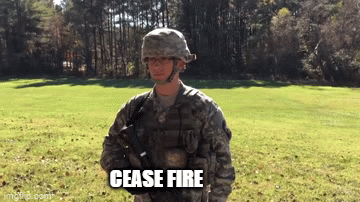Agree with many respondents, but will be clearer yet:
CEASE FIRE (often, 3x) means cease FIRE and nothing else. Unless followed by other instructions, it usually means "and clear the action, let it hang, or step away, as we're changing tasks or someone is going downrange. Indicate when clear." Specifics vary, but the gist is the same always IME.
STOP means Emergency Stop, or "Stop doing absolutely everything." If no one has addressed you or clarified it's for this guy and everyone just resume or cease fire or whatever, after a moment, look at who issued the stop command without moving anything else, and find out if it applies to you. The presumption is the recipient is about to do something dangerous NOW. Movement, firing, anything. Actions on cease-fire may be dangerous so it's a different command.
Replacing Cease Fire with Stop takes away your ability to have an Emergency Stop command. Inconsistency aside, it's potentially more dangerous.
Also to inconsistency: most shooters do not get one range their entire life. Common signals help. One bit of one of my local ranges has a flag code system that is totally dreamed up as far as everyone knows, and it's somewhere between confusing and dangerous. E.g. Red flag showing does not mean Range Hot, but Do Not Fire: People Downrange. Oh, except for the high power range a few hundred m away, where there's a normal flagpole and red means range hot (◔_◔)



